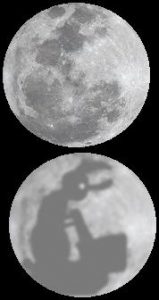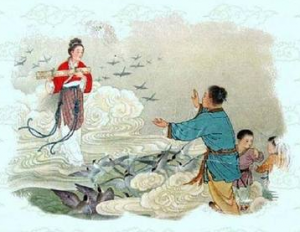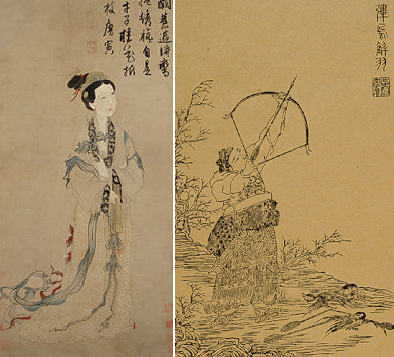Legend has it that Cháng’é was a beautiful woman married to the master archer, Hòu Yì. He was so legendary that he shot down nine of ten suns that had risen together in those distant times, which were scorching the Earth and causing hardship for the people, thus leaving the one sun we have to this day. As a reward for his skill and valor, he was given the elixir of immortality. We don’t know who gave him this magic elixir. We assume it was the gods, but who can say? Anyway, Yì decided not to drink it just then, but instead hid it away at home in the care of his wife, Cháng’é.
As it often turns out in such tales, Yì had an apprentice who was jealous of Yì’s abilities. After watching Yì’s feat and learning of this elixir, he decided he wanted it for himself, so he stole into the house, confronted Cháng’é and demanded the elixir. Cháng’é refused. Struggle ensued, as it does, and instead of giving the elixir away (she was a good wife, Cháng’é), she drank it herself instead rather than let it fall into the wrong hands.
After drinking the elixir, Cháng’é was transported into the heavens, choosing her abode to be on the moon. Upon finding out what had happened, Yì was sad, according to the legend. ‘Sad’ would seem to be an understatement. We’re not told what happened to the apprentice (there are several versions of the tale), but if he were smart he would have left on the nearest chariot to faraway parts of the kingdom, or beyond (preferable), before Yì was able to find him. Anyway, now distraught, Yì would go out when he could see the moon and display the fruits and cakes that Cháng’é liked, being the only way he could express his love for her.
And thus was begun the basis for the Moon Cake Festival in the East, which takes place on the full moon of the 8th lunar month every year. This year that date is Friday, September 13th, the full moon of Virgo. It is the day to honor Cháng’é, but it is also the harvest festival, which is celebrated in the Virgo interval in the northern hemisphere.
 But wait, there’s a rabbit somewhere in this tale, too. As it happened, the moon, which Cháng’é chose as her home, was also the home of a certain Jade Rabbit, Yùtù. Yùtù can be seen in the near face of the moon with his mortar and pestle, pounding out and grinding his potions. The contents of the potions vary according to culture, but for our tale about Cháng’é, Yùtù is pounding out the elixir of eternal life. That comes in pretty handy if you want to live on the moon. As for the lunar rover, it too will be ‘pounding out’ the lunar soil searching for the magic elixir of life – water, among other things. That also comes in handy of you want to live on the moon. So, at least Cháng’é doesn’t have to live alone on the moon. Then there is also something about a magic tree and a three-legged toad on the moon, too, but that is outside our story line.
But wait, there’s a rabbit somewhere in this tale, too. As it happened, the moon, which Cháng’é chose as her home, was also the home of a certain Jade Rabbit, Yùtù. Yùtù can be seen in the near face of the moon with his mortar and pestle, pounding out and grinding his potions. The contents of the potions vary according to culture, but for our tale about Cháng’é, Yùtù is pounding out the elixir of eternal life. That comes in pretty handy if you want to live on the moon. As for the lunar rover, it too will be ‘pounding out’ the lunar soil searching for the magic elixir of life – water, among other things. That also comes in handy of you want to live on the moon. So, at least Cháng’é doesn’t have to live alone on the moon. Then there is also something about a magic tree and a three-legged toad on the moon, too, but that is outside our story line.
That’s one of the love stories, tragic as it was. But at least we get to enjoy our moon cakes each year. Then there is this one:
 Once upon a time in a land far, far away (we’re assuming China) there lived a poor, young ox herder (Niulang) and a weaving maiden (Zhinü), and they were very much in love with each other. In fact, they were married. They were so much in love that their love distracted them from their duties to their heavenly masters. The young lady, the Weaving Maiden, was the daughter of the Sun God (don’t have his name at hand) and she wove the most beautiful bolts of tapestries. The Ox Boy had his herds near the River Han (the Milky Way), where they could drink from the cool, clear waters. The Sun God had betrothed his daughter to the Ox Boy as a reward for their good behavior and work for the realm. But as it came to pass, after marriage the Weaving Maiden lost all interest in her work and adopted a lifestyle of idleness. The Ox Boy was quite distressed at this, and in despair left his herd to fend for themselves. The heavenly masters were not pleased, and in an effort to restore order to the realm, separated the pair forever, whereupon they took up their tasks again. Now they find themselves on opposite sides of the great River Han. But once a year, on the 7th day of the 7th lunar month, they are reunited by means of a bridge formed by a flock of 1,000 magpies (quèqiáo). The Ox Boy is now known as the star Altair, and the Weaving maiden, Vega. Their day is on the 7th of August this year.
Once upon a time in a land far, far away (we’re assuming China) there lived a poor, young ox herder (Niulang) and a weaving maiden (Zhinü), and they were very much in love with each other. In fact, they were married. They were so much in love that their love distracted them from their duties to their heavenly masters. The young lady, the Weaving Maiden, was the daughter of the Sun God (don’t have his name at hand) and she wove the most beautiful bolts of tapestries. The Ox Boy had his herds near the River Han (the Milky Way), where they could drink from the cool, clear waters. The Sun God had betrothed his daughter to the Ox Boy as a reward for their good behavior and work for the realm. But as it came to pass, after marriage the Weaving Maiden lost all interest in her work and adopted a lifestyle of idleness. The Ox Boy was quite distressed at this, and in despair left his herd to fend for themselves. The heavenly masters were not pleased, and in an effort to restore order to the realm, separated the pair forever, whereupon they took up their tasks again. Now they find themselves on opposite sides of the great River Han. But once a year, on the 7th day of the 7th lunar month, they are reunited by means of a bridge formed by a flock of 1,000 magpies (quèqiáo). The Ox Boy is now known as the star Altair, and the Weaving maiden, Vega. Their day is on the 7th of August this year.
Amore. It has always been a puzzle as to why mythological love stories have the propensity to have tragic endings, but there you go. As to how these stories tie in with a space mission, it is pretty simple. If you want to maintain radio contact with a lunar lander and rover on the surface of the far side of the moon, you need a bridge – in this case a Quèqiáo satellite. The Lóngjiāng microsatellite can now send a Dragon river of data back to the Magpie Bridge and thus to Earth. Once the lander is on the moon, then it becomes Cháng’é, or Cháng’é-4 in this case. The Chinese have sort of mashed together two myths here, but we won’t let that bother us. Now, with the satellite in place – excuse me, the Magpie Bridge – Hòu Yì, or the Chinese space center, who now skillfully launches rockets instead of arrows, can ‘share the love’ with Cháng’é-4. And Yùtù, the Jade Rabbit, can begin to pound and grind the lunar dust to find that elusive elixir of eternal life. Legend becomes a reality, in a way. This is the crux of the naming for the various facets of the mission.
Is what has just been described shown in the chart for the landing? Let’s have a look. The chart is below (bigger):

I set the chart for Beijing, since it is a Chinese mission. Actually, since the landing took place on the moon one could set up a chart for any location on Earth, and that opens some interesting possibilities, which we will get to. But the Chinese chart has Pisces rising, Sagittarius on the Midheaven and the Sun conjunct Saturn in Capricorn. The Sun God is big on duty, hence his connection with Saturn in the chart. We find Jupiter on the Midheaven (MC) in the 9th house (long journeys, higher knowledge) just behind the MC, marking a highly successful, long-range mission. If you follow mundane astrology, it is noteworthy that Jupiter in the landing chart is conjunct the US ascendant, with Saturn in the landing chart opposite the US Sun. The success of the mission thus far must be galling to vested interests in the US space program, who would like nothing better than to be a part of history in the making.
We note, too, that the Moon is conjunct Jupiter in the 9th house in the landing chart, again marking a successful moon mission. Jupiter is in the sign it rules in orthodox astrology, as is Saturn in Capricorn. The esoteric motto for Sagittarius is, “I see the goal, I reach that goal, and then I see another”. Space exploration – indeed, science in general – is very much like that. Each discovery answers a few questions (reaches the goal) but then a host of other questions come about as a result, and thus we set for ourselves another goal. The master archer is busy at work in this case, and thus far the mission has been a success.
The Sun/Saturn conjunction is sextile Neptune. Neptune, among many other things, governs elixirs and potions, and what we have with that sextile is a representation of the elixir of longevity, Saturn representing longevity when well aspected, which it is. With Pisces rising in the chart along with Neptune in the 1st house, we might fully expect some important discoveries to be made about water on the moon, too, but also about helium3, which would enable us to power our planet for a very long time. There are many such ‘elixirs’ we might find there. The far side of the moon has many unique features not found on the near side. That astrological combination is also a mark of a dream come true, or a dream made reality, and it certainly is for the Chinese, as well as many scientists internationally. This mission really puts China on the map in space exploration. We note, too, that the Sun, Saturn and Pluto are all in the 11th house of ‘friends, hopes and wishes’, as well as the house of group endeavor, showing the international flavor of the mission. This was an Aquarian type of initiative, a true group endeavor.
Pluto is both the esoteric ruler of the Ascendant and the orthodox ruler of the 9th house. Pluto rules the underworld, as well as underground resources and mineral wealth. And, it is well aspected, being conjunct the Sun and sextile Venus and Ceres. Venus and Mars are in a wide dissociate trine, showing the influence of the lovers in the mythology, as well as increasing the prestige of the Chinese space agency. Mars is just over into pioneering Aries and squared by Mercury, showing the audacious nature of the mission (Mars being in the 5th house), the conflict with the Americans, but it also gives the sharp, critical, analytical edge needed for scientific investigation. The Sun/Saturn sextile to Neptune (also in the 1st house) is a stabilizing factor there.
Then, we find Mercury trine to Uranus, the latter posited in the 2nd house and retrograde. That trine speaks of ingenuity, original thinking, a humanistic outlook and it gives the practical side of thought which enables the types of experiments they have to go smoothly. Uranus is also in pioneering Aries, and this has been a pioneering mission, the first of its kind.
If there is one spoiler in the chart, it is the square of the Moon/Jupiter conjunction to Neptune. But the conjunction itself does much to override the effects of the square. That square introduces a note of fantasy or unrealism which can sabotage plans. It is also a warning not to pin one’s hopes on the stars when better attention should be paid to where one’s feet are on earth. In all, though, this is an extraordinary chart, one befitting of the mission and showing the probability that it should be a resounding success, all other things being equal. There is much more we could say, of course, but this will suffice for our purposes.
There is one big question that bears some thought in all this, though: Who does this mission serve and how will it be a saving force for humanity into the future? I refer here to the Pisces rising in the chart with the Pluto rulership. Will the moon become a contested territory, or will international treaties ensure that the moon remains the domain of all humanity? Will commercial interests take the lead on the moon, or will a unity of nations govern its use and exploration? If water and the helium3 are found there in enough abundance, who controls the resources? Given the world’s present geopolitical tensions, it is not difficult to see where all this might lead. And then there is the alarming though of military applications. Will the moon be militarized, or will it be used solely for peaceful purposes? Given that money governs so much of what goes on in our biosphere, imagine what can take place if very valuable resources are found on the moon. These are questions that need careful consideration, even though we might be a bit premature here.
And then we had mention of charts being set up for locations. That would change the rulerships of the houses. If a chart of the mission is set up for London, for instance, it gives Scorpio rising. The general reaction thus far from London has been favorable, especially among scientists, as one would expect. But there has already been mention in the British press about the rivalry between the US and China and what China ultimately seeks to achieve there. A chart for the US gives Virgo rising, and predictably, the New York Times has made mention of the Chinese rivalry, saying China, “could challenge the United States for supremacy in artificial intelligence, quantum computing and other fields.” But scientists the world over are chuffed at the success of the Chinese mission. Kudos!
So, both the Americans and the Chinese have had success in space exploration in the last few days. And before we close this out, we should mention that the flyby of the Pink Snowman by the New Horizons craft collected data that will take 20 months to download. It now takes 6 hours for the data to reach the Earth from the craft. And once that is done, what then? They hope to find another object to fly by. The power on the craft should last until the 2030s, at which point it would have passed out of the solar system altogether. Ultima Thule is the most distant object in the solar system to have been photographed up close. That in itself is a great achievement. Its flyby of Pluto was one of the most anticipated events in recent years for space buffs. And so, we go on, close to home and far away. Jupiter on the Ascendant of the US was an indicator of their success in space. So again, Kudos!
To me, it matters little who makes these advances. It could be the Americans, the Russians the Chinese, British, French, even the Iranians or Algerians…as long as it advances the human condition, is not militarily based, is open and cooperative with its sister agencies in other nations, I’m all for it. But we do have quite a lot we need to correct here, too. Hopefully, and I think so, the US and China will be on much better terms, as well as the US and Russia in the not-too-distant future. Then we may well see some true international progress in these areas. But for now, I am quite happy about the tale of the Hare, the Moon Maiden and the Magpies!
And what the heck, even though it’s not connected, I still like The Dark Side of the Moon, too.
Featured pic cobbled from Wikimedia commons


Exhilarating synthesis – a golden thread of images woven together. A celebration of greatness by two great countries. Let Light and Love and Power restore the Plan on Earth.